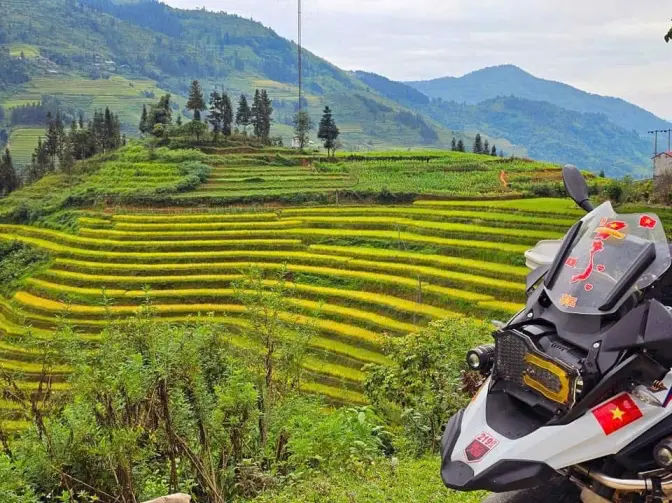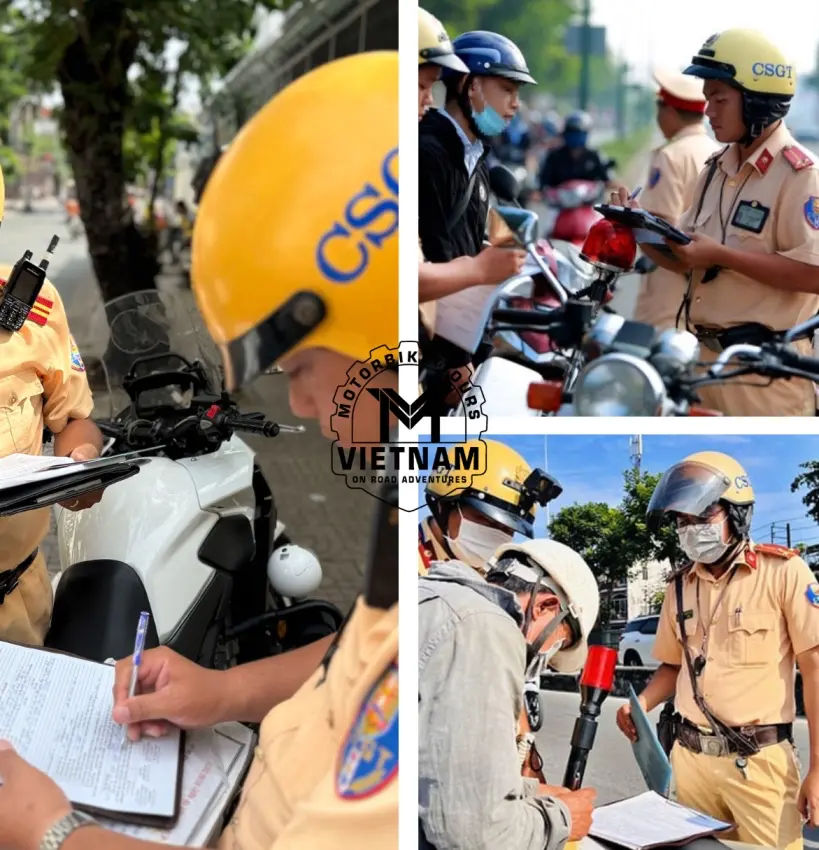
You need an International Driving Permit (IDP) to ride a motorbike legally in Vietnam. This document works alongside your valid driver’s license and translates it into multiple languages, making it easier for Vietnamese authorities to recognize your driving rights. In this guide, I’ll share everything you need to know from personal experience—how to apply for an IDP, the documents you’ll need, and the situations when certification matters most. If you plan to ride a motorbike in Vietnam without a local license, the IDP is your key to driving legally and stress-free.
- Check out how to get Vietnamese driving license
Types of International Driving Permits in Vietnam
When it comes to International Driving Permits (IDPs), there are three global conventions: 1926, 1949, and 1968. Each one has a different level of recognition depending on the country.
⚠️ In Vietnam, authorities only accept the 1968 Convention IDP. That means if you arrive with a 1926 or 1949 IDP, you could face issues at police checkpoints, rental agencies, or even when making insurance claims after an accident.
- Vietnam motorbike tours
- Northern vietnam motorcycle tours
- Ha giang loop motorbike tours
- Women only motorbike tours
What is the 1968 IDP?
This version comes from the 1968 Vienna Convention on Road Traffic. It can last up to three years or until your home country driver’s license expires, whichever happens first. If you’re staying in Vietnam longer—say, for work, study, or extended travel—the 1968 IDP saves you from reapplying every year. Many expats I met in Ho Chi Minh City rely on this type since it’s more convenient for long-term driving.
Understanding the International Driving Permit (IDP) — Vietnam
Heading to Vietnam with plans to ride a motorbike? Get the right IDP first. Below I explain what an IDP looks like, what it contains, and why the 1968 Convention IDP matters for driving legally in Vietnam — with practical tips I’ve learned riding across the country.
What is an IDP and why it matters
An International Driving Permit (IDP) translates the key details from your home-country driver’s license into several languages so foreign officials can read your driving credentials. Vietnam accepts only the 1968 Convention IDP, so bring that version to avoid problems with police, rental agencies, or insurance claims.
What does an IDP look like?
Most IDPs come as a small, passport-sized booklet. Here’s how they usually appear in the hand:
- Booklet format: compact, multi-page booklet that fits a passport pocket.
- Cover: often printed in the issuing country’s language and bearing an emblem or title.
- Photo and holder details: a passport-style photo and key personal data such as full name and date of birth.
- Translated licence pages: your driving licence details translated into major languages so officials understand your permissions.
- Issuing authority and seal: the issuing organisation (for example, a national automobile association) and an official stamp or seal.
The look varies between countries, but the booklet, photo, translations, and issuing details remain consistent features.
What information does an IDP include?
An IDP copies the most important fields from your domestic licence and presents them in a standard, international format. Common fields include:
- Personal information: full name, date of birth, and a recent photo.
- Licence details:
- Licence number
- Date of issue
- Date of expiry
- Vehicle categories allowed (car, motorcycle, truck) indicated with international symbols
- Issuing authority: organisation name, country of issue, and the official stamp or seal.
- Extras: holder signature and any endorsements or restrictions carried from the domestic licence.
Real-world tips from the road
I’ve rented bikes from Hanoi to the Mekong Delta, and these practical tips keep trips smooth:
- Get the 1968 IDP before you fly: many countries issue it through automobile associations or government agencies; apply early so you don’t rush at the last minute.
- Carry both documents: present your original domestic licence together with the IDP when you rent a bike or speak with police.
- Keep backups: photograph both documents and upload them to cloud storage — I once needed digital copies after a wallet theft in Hue.
- Confirm rental requirements: ask rental companies what IDP they accept; some still request specific wording or the original licence.
Quick summary
Before you ride in Vietnam, secure a 1968 Convention International Driving Permit. The IDP booklet translates your licence, lists vehicle categories, and shows who issued the document — everything local officials need to verify your driving rights. Follow the simple tips above and you’ll spend less time on paperwork and more time enjoying Vietnam’s roads.
Obtaining an International Driving Permit (IDP)
Getting an International Driving Permit (IDP) is easier than most travelers expect, but the process varies depending on your home country. Here’s everything you need to know before you head to Vietnam with plans to ride a motorbike or drive.
Step 1: Check your eligibility
You must be at least 18 years old and hold a valid driver’s license from your home country. Without these, you can’t apply.
Step 2: Gather your documents
Prepare the essentials before heading to the issuing authority:
- Your current driver’s license
- Two recent passport-sized photos
- A completed IDP application form
- A valid passport for identification
On my first application, I forgot extra passport photos and had to find a photo booth in the rain—save yourself the hassle and prepare everything in advance.
Step 3: Submit your application
Visit the office of the recognized issuing authority in your country. For example:
- International Driving Permit (IDP) Website
- UK Government Website
- American Automobile Association (AAA)
Some countries allow online or mail-in applications, while others require you to apply in person. If you apply in person, you often walk out with the IDP the same day. By mail or online, expect processing to take a few days to a few weeks, depending on the country.
⚠️ Important: You must apply either in your home country, or online. Vietnam and Thailand do not issue IDPs to foreigners with only their domestic licenses.
Where to apply an IDP
In most countries, the automobile association handles IDP applications. Many now offer convenient online portals. In the U.K., I once walked into a PayPoint store and left with an IDP in less than 15 minutes—it doesn’t get easier than that. You can also apply it online, there are few websites to which you can submit your details and get an IDP as fast as 30 minutes.
Cost of an IDP
The fee remains relatively low worldwide:
- UK: £5.50
- US: $20
Processing time
- In person: Usually same-day service, as long as you have all your documents.
- Online/by mail: Expect delivery in a few days to a couple of weeks.
Final tip before your trip
Apply early—especially if you need your IDP by mail. I’ve seen travelers arrive in Hanoi without the right permit and struggle to rent a motorbike. Save yourself the stress: get your IDP sorted before you board your flight.
Using an International Driving Permit (IDP)
An International Driving Permit (IDP) can save you a lot of stress when driving abroad. It acts as a bridge between your home driver’s license and local authorities, making car rental and traffic stops much smoother. Below you’ll find when to use it, how to use it properly, and what to do if you lose it.
When to Use an IDP
- Driving in countries that require or recommend it: Some countries legally require an IDP, especially where the local language doesn’t use the Roman alphabet or traffic rules differ greatly. Even where it’s optional, having one avoids confusion and speeds up checks.
- Renting a vehicle abroad: Many rental companies ask for an IDP, even if local law doesn’t. It reassures them that your license is valid and recognized internationally.
- Interacting with police or authorities: If you get pulled over or have an accident, an IDP helps officers understand your license details instantly, even across language barriers.
- As extra ID: In some cases, you can use your IDP as a backup identification document if you don’t want to carry your passport everywhere.
- For peace of mind: Even if you’re unsure whether you’ll drive, carrying an IDP means you’re ready for unexpected opportunities or emergencies.
Important Reminders
- Always carry both your home driver’s license and your IDP — the IDP alone is not valid.
- Check the requirements of each country before traveling, as rules vary.
- Apply early since some issuing authorities take weeks to process applications.
How to Use an IDP
- Carry both documents at all times: Police or rental agencies need to see your domestic license alongside the IDP. Without both, your documents may be rejected.
- Present them together: Show both whenever requested — it proves your home license is valid and the IDP provides translations.
- Follow local traffic laws: An IDP does not exempt you from rules. Always respect speed limits, signage, and regulations.
- Check the validity: Most IDPs last 1–3 years but never longer than your home license. Make sure yours stays valid for your entire trip.
- Use it as a translation tool: Its main purpose is helping officials understand your license — think of it as an international “language card” for driving.
- Keep it safe: Store it with your passport or other important documents so you don’t lose it during travel.
What to Do if You Lose Your IDP
Losing your IDP can feel stressful, but you can recover quickly if you take the right steps:
- Contact the issuing authority: If you’re still in your home country, reach out immediately for a replacement. If you’re abroad, your embassy or consulate can guide you.
- Inform your rental agency: If you rented a car with your IDP, let the company know. They might have procedures for lost permits.
- Check local rules: Some countries offer temporary permits — ask the local traffic office or your embassy for details.
- Act quickly: Driving without an IDP in a country that requires it could lead to fines or worse, so resolve the issue promptly.
Tips for Riders
- Keep your IDP in the same pouch as your passport to reduce the risk of misplacing it.
- Store a scanned copy in your email or secure cloud storage — it helps when replacing it abroad.
- Check if your travel insurance covers document replacement costs.
FAQ: International Driving Permit for Vietnam
Do I Need an International Driving Permit (IDP) to Drive in Vietnam?
Yes. You need a valid International Driving Permit (IDP) under the 1968 Vienna Convention to drive legally in Vietnam.
Which Type of International Driving Permit Is Accepted in Vietnam?
Vietnam accepts only the 1968 International Driving Permit (IDP) issued under the Vienna Convention.
What Are the Risks of Driving Without a Valid IDP in Vietnam?
If you drive without a valid IDP in Vietnam, police can fine you, seize your motorbike, or deny your insurance claim after an accident.
How Long Does an International Driving Permit Stay Valid in Vietnam?
An International Driving Permit in Vietnam stays valid for up to three years or until your domestic driver’s license expires, whichever comes first.
How Can I Apply for an International Driving Permit Before Traveling?
You can apply for an International Driving Permit through your home country’s automobile association or licensing authority by submitting your driver’s license, passport photos, and an application form.
Bottom Line: International Driving Permit (IDP)
An International Driving Permit (IDP) makes driving abroad straightforward and legal. With it, you avoid problems such as fines, invalid insurance, or being stopped from renting or operating a vehicle. Plan early and secure your IDP before leaving for Vietnam or any other country on your itinerary.
Disclaimer
This guide shares general travel information about International Driving Permits. It does not replace legal advice. Always confirm the latest IDP rules and requirements with the official authorities in your home country or destination before you travel.
About the Author
Hamid is a passionate ADV rider and seasoned travel writer. With years of experience exploring Southeast Asia on two wheels, he combines first-hand road knowledge with practical travel advice. His goal is to help fellow travelers ride safely, legally, and confidently in Vietnam and beyond.











